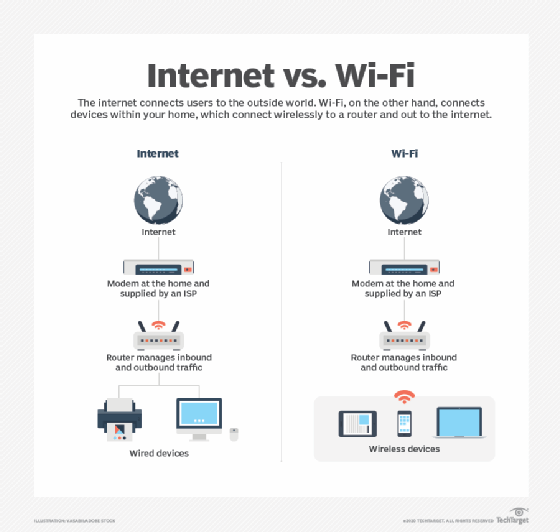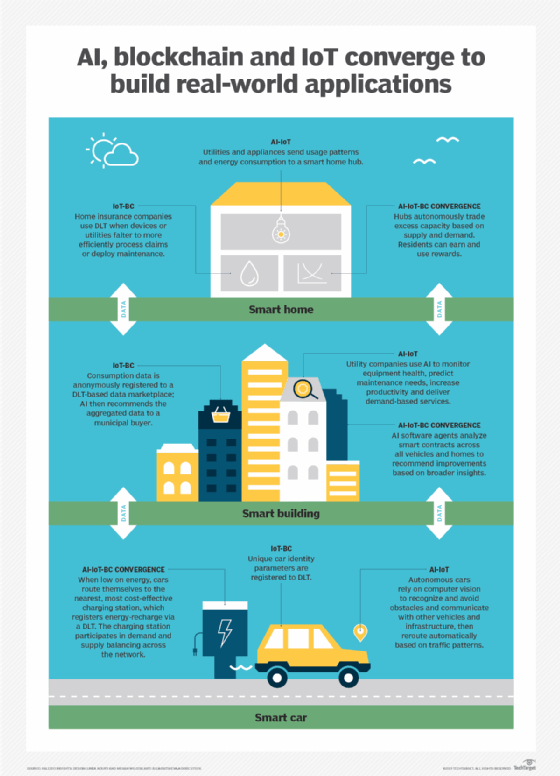How Has The Convergence Of Data, Voice, And Video Changed Our Society?
What is technological convergence?
Technological convergence is a term that describes bringing previously unrelated technologies together, oft in a unmarried device. Smartphones might be the best possible example of such a convergence. Prior to the widespread adoption of smartphones, consumers generally relied on a drove of single-purpose devices. Some of these devices included telephones, wrist watches, digital cameras and global positioning system (GPS) navigators. Today, fifty-fifty low-end smartphones combine the functionality of all these divide devices, easily replacing them in a single device.
Why is technological convergence important?
From a consumer perspective, technological convergence is frequently synonymous with innovation. Technologies rarely converge in their electric current form. Improvements are often introduced as a role of the convergence. Consider the popularity of video cameras a generation ago. Today, consumer-grade video cameras are almost nonexistent. Nigh people tape videos on their mobile devices. Although they can eliminate the demand to acquit a separate device -- a video camera, in this case -- they as well deliver superior video quality as compared to what was in one case available. Video cameras from the early 2000s, usually, had a maximum resolution of 480i (720 10 480) and, oftentimes, experienced poor battery life. In contrast, a mod mobile device can record in 4K resolution. Additionally, their batteries can sometimes last for days, depending on how the device is existence used.
Another reason why technological convergence is important from a consumer perspective is because information technology results in easier admission to technology at a lower cost. This trend is sometimes referred to equally the consumerization of information applied science (IT).
Wi-Fi is a perfect example of this. Wi-Fi was available in the belatedly 1990s, but at the time a Wi-Fi router cost thousands of dollars and, typically, could only be set upwards by an IT pro. Today, Wi-Fi is ubiquitous. Nigh every consumer electronic device is Wi-Fi enabled. Additionally, prices are far lower than they once were, and Wi-Fi routers have been greatly simplified to the bespeak that a non-tech-savvy person can set up them up. Such benefits stem directly from technological convergence.
For businesses, technological convergence means companies are more easily able to connect to their customers and to learn more about client'due south buying habits. In some cases, technological convergence even makes it possible for a concern to influence a customer's purchases. Some retailers track customer's smartphone locations. If a client is continuing in a particular area of the shop for a certain amount of time, the retailer might send the client a coupon via text message or pop-upwards notification for the item they're looking at, thus, further enticing the customer to make a buy.

Types of technological convergence
A adept mode to evaluate the importance of technological convergence is to consider innovations from previous generations. Items such equally CD players, cassette decks, console TVs or corded telephones served merely one function, whereas a single modernistic handheld computing device tin meld several of those functions, with inappreciably any user intervention required.
People who aren't computer-literate are more likely to comprehend the internet and video on demand if they can admission these technologies through their television. TV is familiar and nonthreatening. Displays are large and TVs are easy to operate. Using them to access the web requires virtually no preparation.
PCs, in spite of their graphical user interfaces, tend to exist more than text oriented. They are interactive, geared toward business and education uses, and their displays are smaller. Computers tin exist challenging for some and, often, require formal education or come up with a personal learning curve.
Using a smartphone to brand calls and take digital photos and using your digital Television receiver to perform calculating tasks, such as surfing the web while watching a movie, are ii more examples of technological convergence.
Additional examples include:
- The internet of things (IoT)
- Converged Bluetooth-connected devices
- Loftier-bandwidth Wi-Fi information networks to ability intelligent sensors embedded in:
- Household appliances
- Automobiles
- Thermostats
The history and origin of technological convergence
Technological convergence is the result of disruptive innovation that combined the previously siloed fields of telecommunications, Information technology and media. This motility dates to an era before the prevalence of mobile wireless networks. At the time, telecommunication providers operated fixed phone networks.
Mobile phones appeared in the 1990s as a convenient way to brand phone calls on the go. More than recently, smartphones that support various functions through a single interface emerged -- these functions could include gaming, listening to music, checking email or texting. In addition to multimedia, smart devices include GPS tracking, which supports location-based service for advertising in e-commerce.
Mainstream internet adoption fueled further convergence by telecom service providers. This led to the development of network convergence, or media convergence, which enables data, video and phonation services to be delivered on a single network. Providers one time limited to telephone services tin can offer arranged packages of cable TV, vocalisation and net admission for a monthly rate.
Examples of technological convergence
Bated from telecommunications and media, technological convergence is starting to pervade other erstwhile-line industries. Initially, almost newspapers and other print products had piddling to no internet presence. Over fourth dimension, news outlets recognized the value of integrating new media to deliver real-time content and boost the achieve of advertisers.
Converging technologies fueled the birth of social media applications for sharing content via an online platform. Almost every major media outlet has embraced a software development and Information technology operations (DevOps) approach to create branded applications, where users can collaborate directly with editorial staff and other subscribers via the publisher'southward Facebook page, Twitter handle or chatroom.
Electric vehicles likewise underscore the blurred lines between disparate technologies. Because they run on alternative fuels, these vehicles must tap into an interconnected electricity filigree, while also interacting with internet technologies to analyze and transmit the data they collect.
Artificial intelligence (AI) is the simulation of homo behavior past a computing device. Chatbots are software-driven tools designed with car learning and tongue algorithms. Some companies employ chatbots to handle service inquiries. For case, some online travel agencies use chatbots to assist customers with requests such as canceling a reservation or irresolute their travel dates. The advantages to using this arroyo are that the customer receives firsthand service without having to wait on an amanuensis, and the travel agents are freed up to handle more pressing matters.
Although online travel agencies and other online businesses commonly integrate chatbots into their websites, there are other types of chatbots aside from the ones used for client service. Virtual administration, like Amazon'south Alexa, Apple'southward Siri, Google Assistant and Microsoft's Cortana, are AI chatbots.
Another example of technological convergence is the way that AI, blockchain and IoT technologies are converging to enable a tamperproof ledger. Such ledgers are widely used in banking and cryptocurrency applications simply also have other uses. Some data backup providers, for example, accept adopted blockchain technology as a tool to make sure backups cannot be tampered with or encrypted past ransomware.

Technological convergence besides enables the film industry to lower costs and add more interesting effects with digital product. On the other hand, digitized content is vulnerable to piracy through content ripping, and production houses might lose revenue as more viewers opt for video streaming in place of going to a movie theatre.
Information centers increasingly are because converged infrastructure (CI) or hyper-converged infrastructure (HCI). In CI, companies tin buy compute, networking, server and storage components by the rack. HCI packages all the components on a single apparatus.
What are the advantages of technological convergence?
There are several of import advantages to technological convergence. It tin can spur innovation, while also reducing the need for single-use devices. Part of this innovation has to practice with component miniaturization, as manufacturers must make electronic components smaller and smaller if they are to build evermore capable devices.
Technological convergence too helps consumers use devices in the style that best meets their needs. At i time, making a telephone call was the only option for speaking with someone far abroad. Today, a smartphone supports telephone calls, voice over Net Protocol calls through messaging apps and video calls. Additionally, such devices enable communications through text messages, email and other text-based services.
Technological convergence tin can also assist reduce costs. Purchasing internet, boob tube and telephone service equally a bundle is probable to exist cheaper than subscribing to these services separately. Similarly, buying a smartphone costs less than purchasing a collection of single-purpose devices.
What are the disadvantages of converging technologies?
Despite its advantages, technological convergence comes with notable drawbacks. Due to the complexity of delivering internet, video and voice services, network providers must make necessary expensive investments in computing, networks, security and continuous software evolution. These costs are generally absorbed by consumers in the form of higher rates or service fees.
Additionally, converging services such equally voice, video and cyberspace can increase the severity of an outage. When these services were all separate, a telephone outage would only touch voice service. The same was also truthful for video and internet service. However, when these services are bundled together and delivered through a single connection, a service disruption can potentially lead to customers being without phonation, video and internet for the duration of the outage.
Too, although they compete in a regulated manufacture, telecom service providers own the existing network infrastructure and might exist reluctant to share it with rivals. This provides a barrier to entry for new companies to bring innovations to market place. This situation has led to a debate over internet neutrality rules in the U.S. that were enacted in 2015 to treat broadband services as a utility and prevent providers from giving preference to services they own over competing services. The Federal Communications Commission repealed the rules in 2018 after a series of legal challenges, although individual states are considering passing their ain net neutrality laws.
From a user perspective, form factor plays a role in the efficiency of the converged technologies. Although you can open a browser on a smartphone, a mobile device might not be equipped to provide the same functionality equally a desktop or PC due to the device's relatively small screen size. A physical device's form factor inevitably makes that device better suited to some employ cases over others.
More than importantly, given the pervasive nature of data collection enabled by converged technologies, it tin exist difficult for users to fully understand when information is being mined past technology companies and how it's being used to build a personal contour. Vesture devices, lapses in cybersecurity and the proliferation of mobile devices accept increased the assail surface hackers can use to steal personally identifiable information. These concerns accept sparked fence on the need for additional regulations in the U.S., similar to the General Information Protection Regulation laws that govern data privacy in Eu member countries.
Other security issues can also stem from digital convergence. Consumer-oriented IoT devices have long had a reputation for weak security. If an attacker were to successfully hack such a device, the attacker could potentially use the compromised device as a platform for attacking other devices that are connected to the same network. This tin can include data rich devices such every bit personal computers, tablets and smartphones.
How Has The Convergence Of Data, Voice, And Video Changed Our Society?,
Source: https://searchconvergedinfrastructure.techtarget.com/definition/convergence
Posted by: kingtordese.blogspot.com


0 Response to "How Has The Convergence Of Data, Voice, And Video Changed Our Society?"
Post a Comment